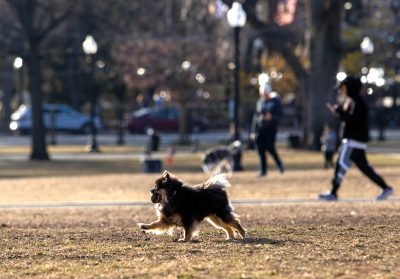Big changes are coming to Boston Common.

Members of the design team for the Boston Common Master Plan presented their proposals Sept. 16 over Zoom. The plans range from the addition of more restroom facilities to a new dog park.
Cheri Ruane, vice president of civil engineering company Weston & Sampson, said the goal of the Master Plan process is to envision restorations to the Common.
“What we’re going to have at the end of the process is a very clear plan for improvements,” Ruane said, “that are both specific to individual areas on the Common, for example the Frog Pond or the playground, but also park-wide systems like lights and pathways and stormwater management.”
Planning began in the spring of 2019 and is expected to be completed this winter. If everything goes smoothly, construction could begin as early as fall of 2021, Ruane said.
The Boston Common Master Plan is funded through the City of Boston. In 2018, the City sold the Winthrop Square garage for development and appropriated the revenue to several public services, one of them being the Boston Common, according to Elizabeth Vizza, president of the Friends of the Public Garden.
The Master Plan will receive $28 million from that sale, Vizza said, with $5 million dedicated to maintenance and $23 million to the implementation of the proposed changes.
The planning process has been a collaborative effort, Ruane said. The design team includes Boston Parks and Recreation, Friends of the Public Garden and Weston & Sampson, as well as consultants for landscaping, soils and management.
Designers and planners for the Boston Common Master Plan have also leaned on public engagement, Ruane said, working with Boston residents to hear their feedback on proposals.
“Boston Common is actually known as the People’s Park, and it is America’s first public park,” Ruane said. “It’s long been considered, really, a place for the community.”
Since the onset of the pandemic, however, much of the efforts to engage the public have shifted online, including discussion forums for residents to voice their opinions.
Many of the changes to the Boston Common address the inaccessibility of the park for those with disabilities, Vizza said.
“Parks are parks for all. Frederick Law Olmsted has a famous quote that said that parks are democracy in trees and dirt,” Vizza said. “They belong to everybody and everybody needs to be able to be welcomed.”
Ruane said some challenges to accessibility arise from the steep topography of the area. One of the major plans to address the issue includes changes to the Park Street station.
“The route from Park Street station up to the Statehouse [is] a really steep pathway,” Ruane said. “That would really be hard to make accessible, but there are certainly areas that we could make accessible through the introduction of sloped walkways and maybe some seating areas.”
Urban designer Margarita Iglesia said accessibility is important in enabling everyone to enjoy the park.
“Large parks like the Boston Common are the places open to everybody, where everybody can go at any time and experience a connection with vegetation and open space,” Iglesia said. “It’s really important that these spaces are accessible.”
Adjustments to the Frog Pond and Tadpole Playground will also address the changing demands of the community.
Planners are looking to double the size of the playground to allow for multi-age use, Vizza said. She added that the Frog Pond will have more food options as well as interactive spray opportunities for children during the summer and a reflecting pool in the spring and fall, with additional seating close by.
More bathroom facilities will also be added, while tennis courts will be re-oriented and a new fenced-in dog park will accompany athletic fields, Vizza said.
The Master Plan will also address sustainability and the environmental benefits that parks can bring to cities, Ruane said. These efforts include removing diseased trees and replacing them with native species, as well as ensuring materials used in the landscape are recyclable and reusable.
“We are really looking at a lot of different things to make the site really benefit the overall ecology and health of the City,” Ruane said.
Parks are a safe haven for many, Vizza said, and with the onset of the pandemic, they have become more vital in providing opportunities to socialize while following public health protocols.
“We know innately that we are connected to nature. We can’t even put words to it, but we know it,” Vizza said. “That really helps us when we’re frightened, alone, sick, lost our job, whatever circumstances people are living with. This gives them some hope and some joy.”
CORRECTION: A previous version of this article misspelled Frederick Law Olmsted’s last name. The article has been updated to reflect these changes.




